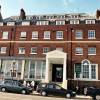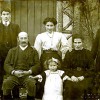There was something very special about the presentation Peter Collins of St Helier Galleries made to Advocate Richard Falle of La Societe Jersiase at St Helier Museum in March 1989. It was a bar of military medals including a conspicuous Victoria Cross which Mr Collins, acting on behalf of Mr Falle, had just bid £12,000 for at a London auction house. The VC had returned to the home of the remarkable and courageous serviceman who had won it 71 years before.
But Jack Thomas Counter, the original holder of the decorations, was no native to the Channel Islands. In fact he was born in Blandford Forum on the 3rd of November, 1898 to Frank and Rosina Counter. After leaving school in his teens, Jack found a job at International Stores, a retailing business in the town. When war broke out in 1914 Counter, possibly too young then to serve, joined the action after the introduction of conscription as a private in the 1st Battalion of the King’s Liverpool Regiment in February, 1917. Posted to France, he served with his battalion, which had become engaged with the Germans at Boisleux St Marc.
On 16th April, 1918 Counter’s company faced an enemy breakout, making it critical for a reconnaissance detachment to be sent across the line to gather intelligence. A detail of five other men went out, but all were killed in full view of Jack Counter, who then volunteered to go alone after the decision was made that a lone runner would stand a better chance of surviving to report back. Thus facing almost certain death under enemy fire Counter achieved the objective of returning with the information, enabling his commanding officer to launch a new offensive to recover the regiment’s lost ground.
This alone was an outstanding act of selfless courage, but Jack Counter went on to carry no fewer than five other messages to company HQ across the battlefield under heavy artillery fire. It was following the last of these assignments that he was awarded the Victoria Cross, an occasion reported in the London Gazette of May 23rd, 1918. On the 28th of June, following his investiture by King George V, he returned home to a hero’s welcome at Blandford station, being met by the town’s Mayor, its Corporation and, it seemed, almost the entire population as a tumultuous crowd. Blandford’s Band led Counter and the welcoming party to the market square in an open landau, where Counter was made the very first Freeman of the Borough and presented with a magnanimous War savings certificate and a gold watch, a gift from his employers at International Stores.
While still in the army Counter was promoted to Corporal, a rank, friends were told, he only accepted to avoid the indignity of spud-bashing. Certainly he never contemplated making the army his profession. On being demobbed in the Channel Islands in 1922 he decided to settle and make his home there, soon finding a job as an auxiliary postman at St Ouen, Jersey.
Three years later however, he was seconded to the Post Office at Sudbury Common, Middlesex, remaining there until 1929, when he returned to St. Helier to fill the position of the town’s postman. This work continued throughout the occupation of the Channel Islands by the Germans in World War 2, by which time Jack had met and married a local Jersey woman and by her had a daughter. While still working as a postman, Counter was further awarded the Imperial Service Medal. He would remain in Jersey for the rest of his working life.
The war over, Counter retired from the postal service on April 11, 1959, although he worked for some years more for two local businesses, G.D. Laurens and R Le Ball & Co. During the years of his retirement he returned to visit the family home in Blandford’s Dorset Street several times.
Of course as an ex-serviceman it was natural that Jack Counter should join the Jersey branch of the British Legion, in his case as member 499 in 1930. Yet it was typical of this war hero that he would not be content with a mere passive supporting role out of respect for fallen comrades. He took an active part in the British Legion’s administration as a general committee member, during which time he often joined in games of tombola and housey-housey at social evenings organised at the Hotel de L’Europe.
But to the Jersey public he was a proud soldier who bore the Kings, later Queens. Standard at Armistice Day and other Legion parades. Counter also relished being in the colour-party, carrying the Sovereign’s colour in the presentation of the Festival of Remembrance. For this involvement, Counter even became known as Jersey’s VC.
Throughout his life Jack Counter was by nature a person of ever-cheery demeanour and kindly words. Former Blandford Town Clerk and Freeman Charles Lavington recalls Jack as shy and unassuming – possibly the most unlikely character credentials for a future VC holder. The many friends he made in St. Helier could attest that he was modest and jovial, a leading light in the Jersey British Legion.
But despite his valiant early years the happiness of his twilight ones were shattered by two dreadful blows. The first came in 1964 when his much-loved daughter – his only child – died before reaching middle age. Then only six years later his wife died, leaving him sole survivor of the family he created, and isolated by sea on an offshore state miles from his native county. Now alone, Jack’s nearest kin were a sister-in-law in Blandford and a sister (Mrs Gertrude Weeks) and niece living in Bristol, with whom he maintained contact through occasional visits.
Jack Counter was making one such holiday visit to his sister and niece in Bristol in September 1970, only months after the death of his wife earlier that year. After a few days together brother and sister made a day-trip to visit Jack’s sister-in-law in Blandford. Later that afternoon, when one or both women were out of the room making tea, Jack suddenly collapsed – within an hour of being about to leave to catch the return coach to Bristol. A doctor was called to the Dorset Street home, but found the 71-year-old war veteran-hero to be dead.
For the two towns of Blandford and St Helier the emerging news was devastating. Jack Counter was taken to Bournemouth for cremation, his ashes then being taken back to St. Helier, where a memorial service was held in St. Andrews Church, First Tower. A plaque put to his memory near the church war memorial reads:
“To the Glorious Memory of Jack Counter VC, from his Friends and Comrades in the British Legion, 1970″
Nor were these the only tributes. Within a year of his death Counter was even portrayed on a postage stamp: to commemorate its half-centenary in 1971 the British Legion was honoured with a special issue of four from the Jersey Post Office, including one depicting the veteran with his VC. Just five years later in 1976, when the site of the former Seaview and St. Helier Cottages at First Tower were rebuilt as 15 flats for the elderly, the town council named the new development “Jack Counter Close”. Blandford honoured him with a wreath from the British Legion, and a cushioned wreath presented by his family, which were placed at the base of the war memorial in the cemetery.
In February 1989 Blandford Museum Curator Benjamin Cox, who already held an archive of material on Jack Counter, admitted he would welcome the medal back, but could not ensure the money or security for it. The Kings Liverpool Regimental Secretary, Major Bob Baker, also considered whether to bid for the VC after it was learnt that a Canadian, who had had Counter’s VC and other medals in his collection for some years, was putting them up for auction at Glendinings in London. The Jersey branch of the British Legion were also thought to be likely bidders, but in the end it fell to Richard Falle of La Societe, through his agent, Peter Collins, to make the bid that bought back for Jersey Jack Counter’s medals. Collins, in fact, had only to bid against one other (unknown) person, who stopped bidding at £11,500.
Besides the VC and the Imperial Service Medal, the Bar also carried a British War Medal., Victory Medal, a George VI Coronation Medal (1937) and an Elizabeth II Coronation Medal (1953). No one could or would deny that Jack Counter deserved his VC. He accepted his decoration with alacrity and pride, although there nevertheless remained at the back of his mind the conviction, perhaps even guilt that it should also have been awarded posthumously to five courageous men who didn’t make it – ghost runners now – cut down on the battlefield at Boisleux St Mare that death and glory day in 1918.
We have posted a photograph of Jack Counter V.C. in the photo section.



